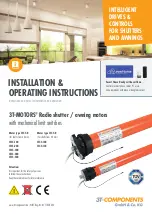
Electrical System
45
62 690 01 Rev. J
KohlerEngines.com
Electronic Ignition Systems Tests
NOTE: Ignition tester must be used to test ignition on these engines. Use of any other tester can result in inaccurate
findings. Battery on unit must be fully charged and properly connected before performing tests (a battery that
is hooked up or charged backward will crank engine but it won’t have spark). Be certain drive is in neutral and
all external loads are disconnected.
Special Tools Required:
● Hand tachometer.
● Ignition tester.
● Automotive timing light.
● Multi-meter (digital).
Specifications Required:
● 0.76 mm (0.03 in.).
Test Ignition Systems
NOTE: If engine starts or runs during testing, you may need to ground kill lead to shut it down. Because you have
interrupted kill circuit, it may not stop using switch.
Isolate and verify trouble is within engine.
1. Locate connectors where wiring harnesses from engine and equipment are joined. Separate connectors and
remove white kill lead from engine connector. Rejoin connectors and position or insulate kill lead terminal so it
cannot touch ground. Try to start engine to verify whether reported problem is still present.
Condition
Possible Cause
Conclusion
Problem goes away.
Electrical System
Check key switch, wires, connections,
safety interlocks, etc.
Problem persists.
Ignition or Electrical System
Leave kill lead isolated until all testing
is completed.
Identify white kill lead of engine
wiring harness connector. Establish
a connection to a known good
ground location. Engine should kill
completely. If not or only one cylinder
is affected, test ignition modules and
white kill lead connection for affected
DSAI module (DSAI only).
Test for Spark
NOTE: If 2 testers are available, testing can be performed simultaneously for both cylinders. However, if only 1 tester
is available, 2 individual tests must be performed. Side not being tested must have spark plug lead connected
or grounded. Do not crank engine or perform tests with 1 spark plug lead disconnected and not grounded, or
permanent system damage may occur.
1. With engine stopped, disconnect 1 spark plug lead. Connect spark plug lead to post terminal of spark tester and
attach tester clip to a good engine ground.
2. Crank engine over, establishing a minimum of 550-600 RPM, and observe tester(s) for spark.
3. Repeat spark test on opposite cylinder if cylinders are being tested individually.
Condition
Possible Cause
Conclusion
Both cylinders have good spark but
engine runs poorly or existing plug
condition is questionable.
Spark Plug(s)
Install new spark plug(s) and retest
engine performance.
If problem persists, check for timing
advance (DSAI only).
1 cylinder has good spark and other
cylinder has no or intermittent spark.
Ignition
Test ignition modules and
connections.
Spark on both cylinders but power is
suspect.
Timing Advance
Sheared Flywheel Key
Check for timing advance (DSAI
only).
Check for broken key.
















































